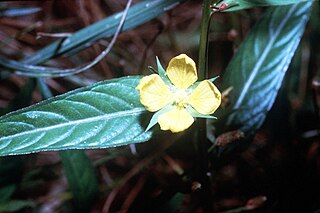
Ludwigia alternifolia, commonly known as seedbox, bushy seedbox, rattlebox, and square-pod water-primrose, is a herbaceous perennial plant of the family Onagraceae. It is native to central and eastern North America, growing in marshes, wet meadows, and swamps. It has yellow, four-petaled flowers and brown seed pods that are shaped like a cube.

Packera obovata, commonly known as roundleaf ragwort, spoon-leaved ragwort, roundleaf groundsel, or squaw-weed, is an erect perennial herb in the Asteraceae (aster) family native to eastern North America. It was previously called Senecio obovatus. Basal and lower leaves are obovate with toothed margins, while upper leaves are pinnately divided. The ray flowers are yellow and the disk flowers orange-yellow, the inflorescences being held well above the foliage.

Liatris pycnostachya, the prairie blazing star, cattail gayfeather or cattail blazing star, is a perennial plant in the Asteraceae family that is native to the tallgrass prairies of the central United States.

Rudbeckia triloba, the browneyed or brown-eyed susan, thin-leaved coneflower or three-leaved coneflower, is a species of flowering plant in the family Asteraceae with numerous, yellow, daisy-like flowers. It is native to the central and eastern United States and is often seen in old fields or along roadsides. It is also cultivated as an ornamental.

Echinacea simulata, commonly called wavy leaf purple coneflower, glade coneflower, or prairie purple coneflower, is a species of perennial flowering plant in the family Asteraceae. It is native to the east-central states of the United States. Its natural habitat is dry, calcareous, open areas such as barrens and woodlands.

Symphyotrichum laeve is a flowering plant native to Canada, the United States, and Coahuila (Mexico). It has the common names of smooth blue aster, smooth aster, smooth-leaved aster, glaucous Michaelmas-daisy and glaucous aster.

Ratibida columnifera, commonly known as upright prairie coneflower, Mexican hat, and longhead prairie coneflower, is a perennial species of flowering plant in the genus Ratibida in the family Asteraceae. It is native to much of North America and inhabits prairies, plains, roadsides, and disturbed areas from southern Canada through most of the United States to northern Mexico.

Erigeron annuus, the annual fleabane, daisy fleabane, or eastern daisy fleabane, is a species of herbaceous, annual or biennial flowering plant in the family Asteraceae.

Cirsium discolor, the field thistle, is a North American species of plants in the tribe Cardueae within the family Asteraceae. It is native to thirty-three states in the United States as well four Canadian provinces. It occurs across much of eastern and central Canada as well as eastern and central United States. It has been found from New Brunswick west to Saskatchewan and south as far as Texas and Georgia.

Symphyotrichum sericeum is a species of flowering plant in the family Asteraceae native to central North America. Commonly known as western silver aster, western silvery aster, and silky aster, it is a perennial, herbaceous plant that may reach 70 centimeters tall. Its flowers have purple ray florets and pink then purple disk florets, and its leaves are firm and silvery-green.
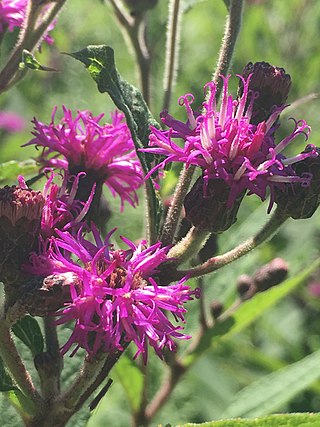
Vernonia missurica, the Missouri ironweed, is a species of magenta-flowered perennial plant from family Asteraceae native to the central and east central United States.

Conoclinium coelestinum, commonly known as blue mistflower, mistflower, wild ageratum, or blue boneset, is a North American species of herbaceous perennial flowering plant in the family Asteraceae. It was formerly classified in the genus Eupatorium, but phylogenetic analyses in the late 20th century research indicated that that genus should be split, and the species was reclassified in Conoclinium.

Verbesina virginica, known by the common names white crownbeard, or frostweed is a species of flowering plant in the family Asteraceae. It is native to the Southeastern United States, where it is found in calcareous soil, often in bottomland thickets and edges of woods.
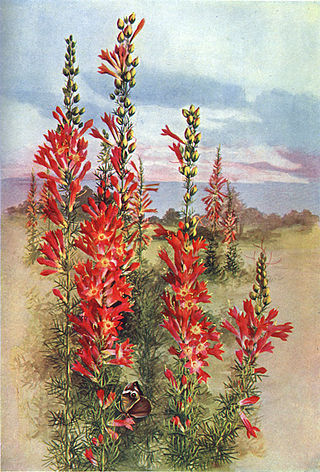
Ipomopsis rubra is a flowering plant of the phlox family native to North America in the state of Texas and the southeastern United States, commonly known as standing cypress, scarlet gilia, Texas plume, flame flower, and indian spur. This classification is synonymous with Gilia rubra. This flower is noteworthy for its bright, upturned flowers.
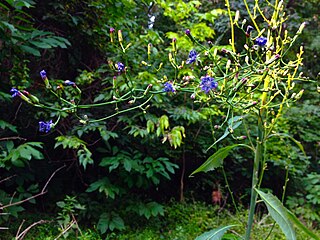
Lactuca floridana, commonly known as woodland lettuce, Florida lettuce, or false lettuce is a North American species of wild lettuce. It is native across much of central Canada and the eastern and central United States.

Verbesina occidentalis is a flowering plant in the family Asteraceae. The common names for Verbesina occidentalis are yellow crownbeard and stick weed. Verbesina occidentalis is often considered a weedy plant of disturbed areas, due its presence in managed agricultural areas such as hayfields.
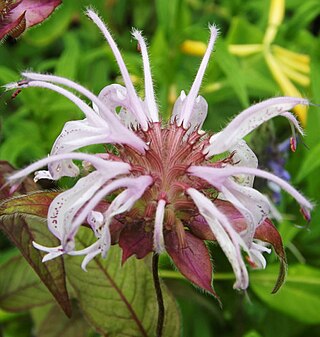
Monarda bradburiana, the eastern beebalm or Bradbury's beebalm, is a species of perennial flowering plant in the mint family, Lamiaceae, that is native to much of the southeastern United States.

Vernonia baldwinii, commonly known as western ironweed or Baldwin's ironweed, is a perennial herb native to the central United States. It is in the Asteraceae (aster) family.

Verbesina helianthoides, commonly called yellow crownbeard or gravelweed, is a species of flowering plant in the family Asteraceae. It is native to the United States, where it is primarily found in the Upper South and South Central areas. Its natural habitat is in communities that receive ample sunlight, such as open woodlands, prairies, and glades.
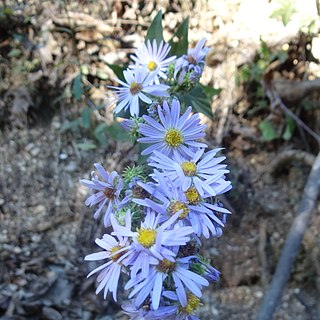
Symphyotrichum anomalum is a species of flowering plant in the family Asteraceae native to Arkansas, Illinois, Kansas, Missouri, and Oklahoma. Commonly known as manyray aster, it is a perennial, herbaceous plant that may reach 20 to 120 centimeters tall. Its flowers have lavender or blue to purple, seldom white, ray florets and cream or light yellow, then pinkish-purple disk florets. Its flowers are attractive to butterflies. The lower leaves have untoothed margins and are heart-shaped at the base.

























